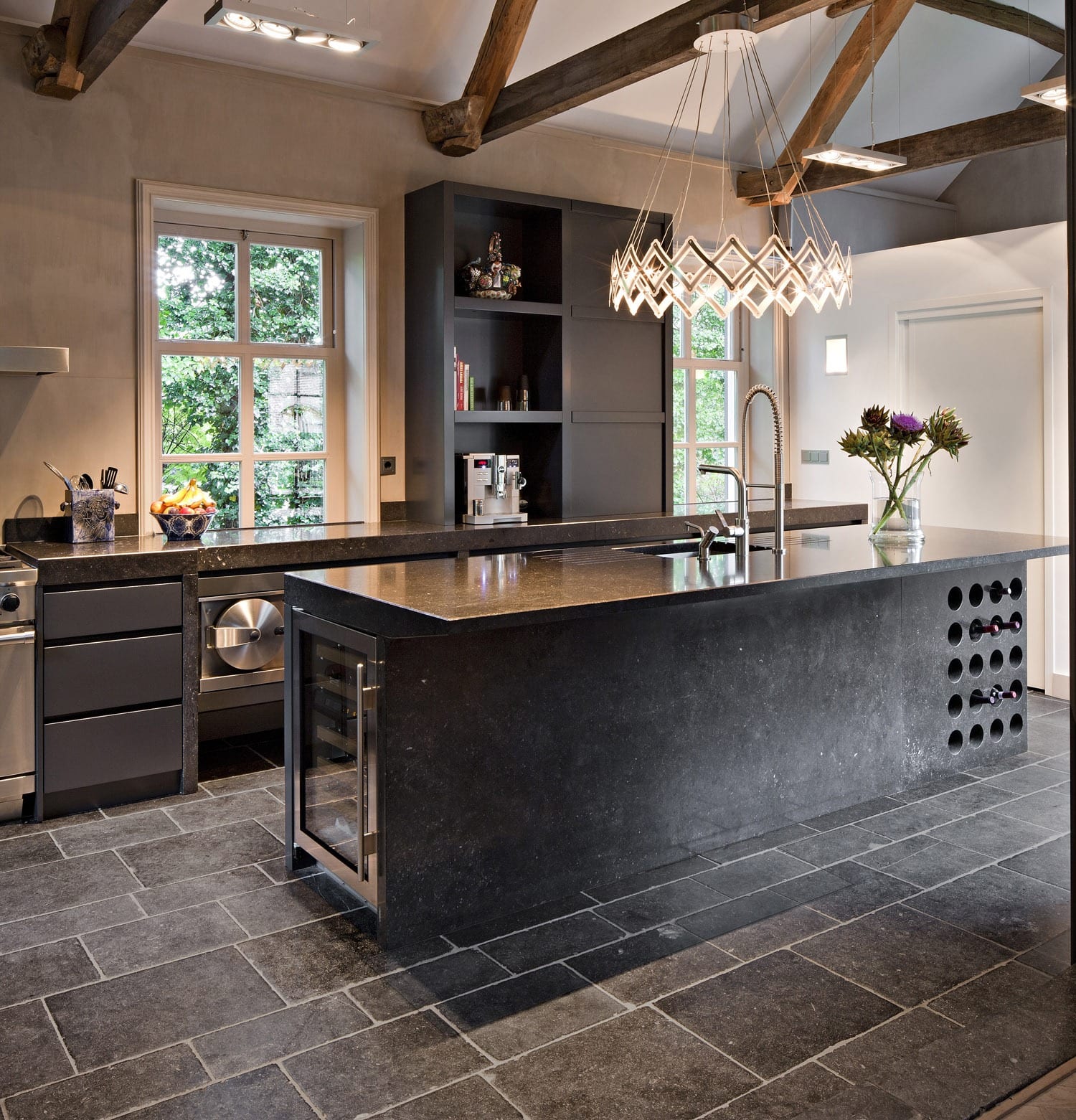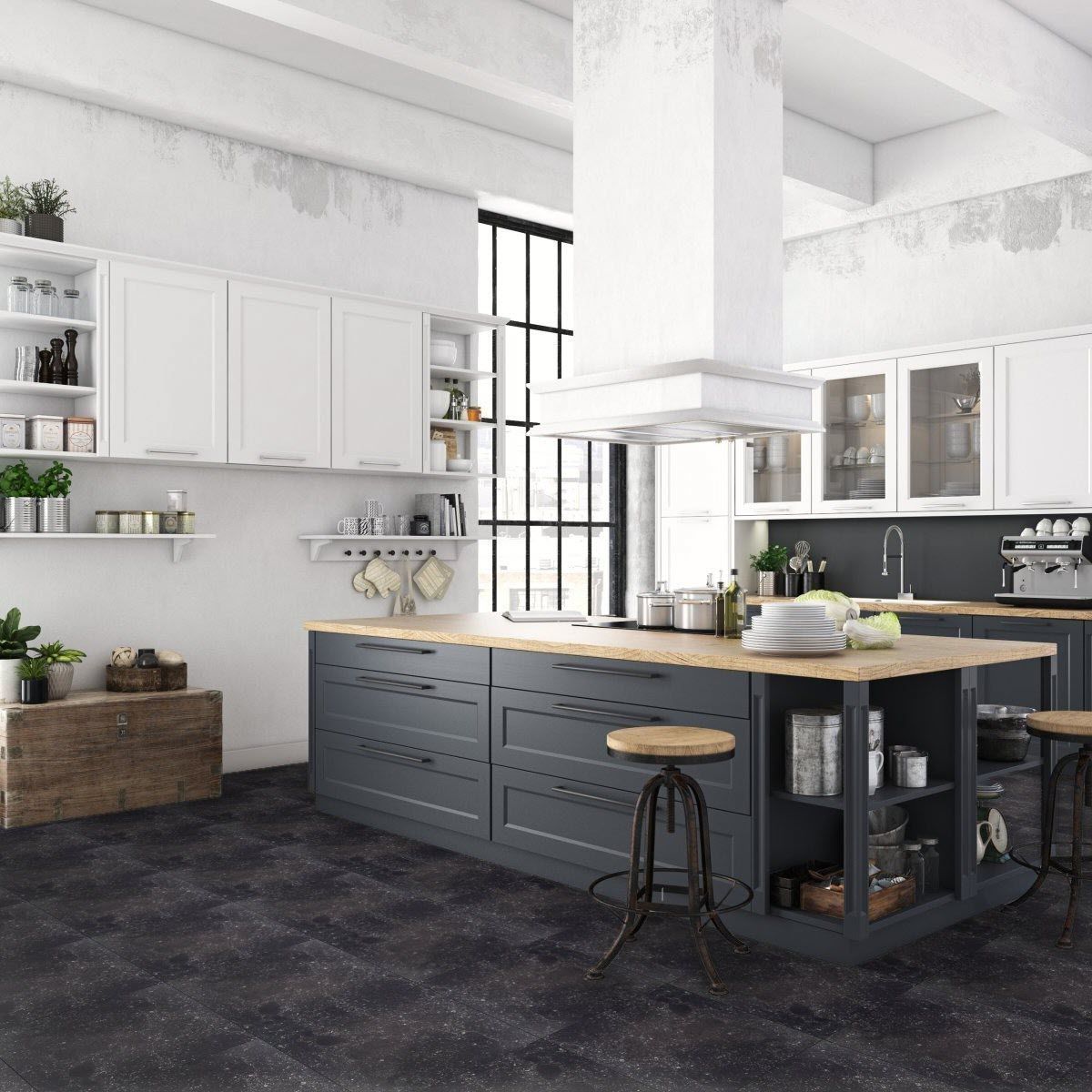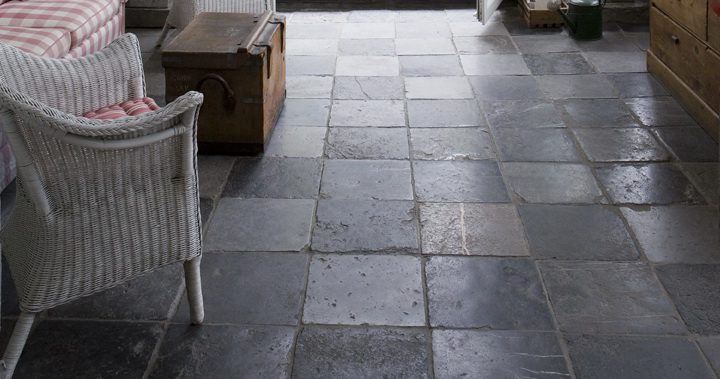Why Bluestone is a Perfect Choice for Kitchen Floors
When it comes to kitchen flooring, few materials offer the timeless beauty, durability, and natural appeal of bluestone. Bluestone is a type of natural stone that stands out for its rich color variations and unique texture, making it an ideal choice for kitchens where both aesthetics and practicality are essential. let’s find out why bluestone could be the perfect fit for your kitchen floor.
- Durability and Strength: One of the biggest reasons bluestone is ideal for kitchen floors is its incredible durability. Kitchens are high-traffic areas, and the floor needs to stand up to daily wear and tear. Bluestone is incredibly tough and resistant to cracking or chipping, so it can handle everything from dropped pans to heavy foot traffic without showing signs of damage.
- Naturally Slip-Resistant: Bluestone’s natural texture gives it an inherent slip-resistant quality, which is particularly important in a kitchen where spills are inevitable. The slightly rough surface of bluestone provides traction, helping prevent accidents, especially in households with children or elderly family members. You can feel confident knowing that your kitchen floor is both safe and stylish.
- Aesthetic Versatility: Bluestone offers a stunning range of shades, from deep blues and grays to soft browns and greens. This variety allows it to complement different kitchen designs, whether you’re going for a modern, rustic, or traditional look. Its natural veining and color variation also add character, ensuring that no two bluestone floors are the same.
- Heat and Stain Resistance: Another reason bluestone works so well in the kitchen is its ability to withstand heat and stains. This is especially beneficial in a space where you’re cooking and handling hot pans or spills. Bluestone’s natural properties make it resistant to both heat and stains, which means it’s easy to clean and maintain its beauty over time.
- Complements a Range of Materials: Whether you pair it with wood cabinetry, stainless steel appliances, or marble countertops, bluestone seamlessly integrates with a variety of kitchen materials. Its neutral yet dynamic tones make it a versatile choice that can either stand out as a feature or blend in harmoniously with other design elements.
- Long-Lasting Investment: While bluestone may come with a higher upfront cost compared to some other flooring options, it’s a long-lasting investment. This type of stone can last for decades, and in many cases, it only gets more beautiful with age. You won’t have to worry about replacing it anytime soon, making it a smart choice for homeowners looking for a high-quality, long-term flooring solution.

Top Benefits of Bluestone Flooring in the Kitchen
Installing bluestone in your kitchen doesn’t just enhance the look of your space – it comes with a whole host of practical benefits as well. From its unique beauty to its durability, bluestone can transform a kitchen into a functional yet stylish hub of the home. Here are the benefits of choosing bluestone flooring for your kitchen.
Natural Beauty
One of the standout features of bluestone is its natural beauty. With its rich, earthy tones and unique patterns, it brings a sense of the outdoors into your home. Bluestone adds character to the kitchen, making the space feel more grounded and inviting. The stone’s unique veining means that every tile or slab is one-of-a-kind, giving your kitchen a truly custom look.
Durability for Heavy Traffic Areas
Kitchens are busy places, and the floor needs to be able to handle the constant movement. Bluestone is extremely durable and can easily stand up to the high traffic that most kitchens see. Whether you’re moving heavy furniture or dealing with everyday foot traffic, bluestone won’t wear down or show signs of damage like softer materials might.
Low Maintenance
While some natural stones require a lot of upkeep, bluestone is surprisingly low maintenance. With regular sweeping and occasional mopping, you can keep your bluestone floors looking fresh and clean. For an added layer of protection, you can seal the stone, but even without sealing, bluestone’s natural toughness makes it resistant to stains and spills.
Perfect for Indoor and Outdoor Flow
If your kitchen opens out onto an outdoor area, bluestone is the perfect choice for creating a seamless indoor-outdoor flow. Many people use bluestone for patios or walkways, so using it in the kitchen can tie the two spaces together beautifully. This is especially appealing for those who enjoy entertaining or love to keep their doors open in nice weather.
Resistance to Scratches and Dents
One of the common concerns with kitchen floors is how well they’ll stand up to heavy use. Bluestone’s natural hardness makes it incredibly resistant to scratches and dents. This means you don’t have to worry as much about dragging heavy furniture or dropping kitchen tools, which is a huge plus in a busy kitchen.
Timeless Appeal
Bluestone has a timeless quality that makes it suitable for any design style. It never goes out of fashion, and its natural charm can complement modern, classic, or even industrial kitchen styles. This long-lasting aesthetic appeal means you won’t feel the need to update your kitchen floor as trends change.
Bluestone Kitchen Floor Maintenance
While bluestone is known for its durability, proper maintenance is essential to keep it looking its best for years to come. Fortunately, maintaining a bluestone kitchen floor is relatively easy, but there are a few steps you should follow to preserve its natural beauty. Let me share the best practices for maintaining your bluestone kitchen floor.
Sweep Regularly to Remove Dirt and Debris
Bluestone’s textured surface can trap dirt and debris, which can dull its appearance over time. To prevent this, it’s important to sweep or vacuum the floor regularly. A soft-bristle broom or a vacuum with a hard floor setting works well to remove particles without scratching the surface.
Clean Spills Immediately
While bluestone is resistant to stains, it’s still a good idea to clean up any spills as soon as they happen. Acidic substances like lemon juice, vinegar, or wine can potentially stain or etch the surface if left too long. Simply wipe up spills with a damp cloth to prevent any long-term damage.
Use a pH-Neutral Cleaner
When it’s time to mop the floor, use a pH-neutral cleaner that’s specifically formulated for natural stone. Harsh cleaners or acidic products can damage the stone’s surface or wear away any sealant you’ve applied. Stick to gentle, stone-friendly cleaners to keep your bluestone looking vibrant and fresh.
Seal the Floor for Added Protection
Sealing your bluestone kitchen floor can provide an extra layer of protection against spills, stains, and general wear. While bluestone is naturally durable, sealing helps preserve its finish and makes it even easier to clean. Depending on the type of sealant, you may need to reseal the floor every couple of years, but it’s a small effort for long-term beauty.
Use Rugs or Mats in High Traffic Areas
To further protect your bluestone kitchen floor, consider placing rugs or mats in high-traffic areas, such as in front of the sink or stove. These areas tend to see more wear and tear, and rugs can prevent dirt and spills from accumulating on the floor. Make sure the rugs have a non-slip backing to keep them securely in place.
Avoid Dragging Heavy Furniture
While bluestone is highly scratch-resistant, dragging heavy furniture or appliances across the floor can still cause damage. Always lift furniture when moving it, and consider placing felt pads under the legs of chairs or tables to avoid scratching the surface.
Designing Your Kitchen with Bluestone: Tips and Ideas
If you’ve decided to go with bluestone for your kitchen floor, you’re in for a treat. The versatility and beauty of this stone make it easy to incorporate into any design style. Whether you’re aiming for a modern kitchen or something more rustic, bluestone can be the foundation of a stunning design. Let’s explore some creative ways to design your kitchen with bluestone.
Pair Bluestone with Warm Wood Accents
One of the most beautiful combinations is bluestone with natural wood. The cool tones of bluestone are balanced perfectly by the warmth of wood cabinetry, shelves, or furniture. This pairing creates a cozy yet modern aesthetic that works in both traditional and contemporary kitchens.
Create a Seamless Indoor-Outdoor Connection
If you have a kitchen that opens onto a patio or outdoor space, consider using bluestone for both areas. This creates a seamless transition between indoor and outdoor living spaces, especially if you enjoy entertaining or dining outside. The natural tones of bluestone blend well with outdoor elements like greenery and stone features.
Use Bluestone as a Statement Floor
Bluestone’s natural variations in color and texture make it a stunning statement floor on its own. You don’t have to add too many other design elements – the floor can be the focal point. Opt for larger bluestone tiles or slabs to create a continuous, elegant look that draws the eye.
Add Contrast with White or Light Cabinets
For a more contemporary or minimalist kitchen, consider pairing bluestone with white or light-colored cabinetry. The contrast between the dark, earthy tones of bluestone and the brightness of white cabinets can create a striking yet balanced look. It’s a great way to keep the kitchen feeling light and airy while still incorporating the rich character of natural stone.
Experiment with Patterns and Layouts
Bluestone doesn’t have to be laid out in traditional square or rectangular tiles. You can experiment with different patterns, such as herringbone, chevron, or even mosaic designs. These unique layouts can add an element of surprise to your kitchen and help you create a truly custom look.
Incorporate Metal Accents for an Industrial Look
For an industrial-inspired kitchen, pair bluestone with metal accents like stainless steel appliances, black fixtures, or exposed piping. The rugged texture of bluestone complements industrial elements beautifully, adding warmth and depth to an otherwise sleek design.
Is Bluestone Right for Your Kitchen? Pros and Cons to Consider
Deciding whether bluestone is the right material for your kitchen floor involves weighing the pros and cons. While bluestone has many advantages, it’s not without its drawbacks. Let’s take a closer look at the pros and cons to help you determine if bluestone is the best choice for your kitchen.
Pro: Durability and Longevity
One of the biggest advantages of bluestone is its durability. This stone can withstand heavy foot traffic, resist scratches and dents, and last for decades with proper care. If you’re looking for a long-lasting flooring option, bluestone is hard to beat.
Con: Cold Underfoot
Bluestone, like most natural stones, can feel cold underfoot, especially in the winter months. While this might be a benefit in warmer climates, it’s something to consider if you live in a cooler area. Radiant heating systems can be installed under bluestone floors to counteract this, but that adds to the overall cost.
Pro: Slip-Resistant Surface
Bluestone’s textured surface makes it naturally slip-resistant, which is a great feature for kitchens where spills are common. This can give you peace of mind, particularly if you have kids or elderly family members at home.
Con: Can Be Pricey
Bluestone is often more expensive than other flooring materials, such as ceramic tile or vinyl. While it’s an investment that pays off in the long run due to its durability, the higher upfront cost can be a drawback for some homeowners.
Pro: Timeless and Versatile Aesthetic
The timeless beauty of bluestone means it will never go out of style. It can suit a wide range of kitchen designs, from rustic and traditional to sleek and modern. Its versatility makes it a great choice if you’re looking for a floor that will stand the test of time, both in terms of durability and style.
Con: Requires Sealing and Regular Maintenance
While bluestone is relatively low-maintenance compared to other natural stones, it does require periodic sealing to keep it looking its best. If not sealed properly, it can be prone to stains and water damage, especially in a kitchen where spills and moisture are common.
Cost of Installing Bluestone Kitchen Floors: What to Expect
When it comes to natural stone flooring, bluestone is often considered a premium option, and with good reason. Its durability, beauty, and versatility make it a top choice for many homeowners. However, it’s important to understand the costs involved before committing to bluestone for your kitchen floor. Here’s what you can expect when budgeting for a bluestone kitchen floor installation.
Material Costs: Bluestone Price Per Square Foot
The cost of bluestone itself can vary depending on the quality, thickness, and source. On average, you can expect to pay anywhere from $10 to $30 per square foot for the material. Higher-end bluestone with unique coloring or finishes may cost even more. It’s a good idea to shop around and get multiple quotes from suppliers to find the best deal.
Installation Costs: Professional Labor Fees
Installing bluestone isn’t a DIY-friendly project for most people, so you’ll likely need to hire a professional. The cost of installation can range from $5 to $15 per square foot, depending on the complexity of the project, the region you live in, and the experience of the contractor. Make sure to get multiple quotes to ensure you’re getting a fair price.
Additional Costs: Sealing and Preparation
In addition to the cost of materials and labor, there are a few other expenses to consider. Bluestone floors need to be sealed after installation, which adds to the overall cost. Sealing typically costs between $1 and $2 per square foot. If your kitchen floor needs to be leveled or prepared before installation, that could add to the price as well.
Radiant Heating: A Luxurious Addition
If you’re concerned about bluestone’s tendency to feel cold underfoot, you might want to consider installing radiant heating beneath the floor. This is a luxurious option that adds warmth and comfort, but it can significantly increase the cost of the project. Radiant heating systems can cost anywhere from $10 to $20 per square foot to install.
Long-Term Savings: Durability and Low Maintenance
While the initial costs of installing bluestone may seem high, it’s important to factor in the long-term savings. Bluestone is incredibly durable, so you won’t have to worry about replacing it anytime soon. Additionally, its low maintenance requirements mean you’ll save on upkeep costs over the years.
Budgeting Tips: How to Save on Bluestone Floors
If you’re set on bluestone but need to stick to a budget, there are a few ways to cut costs. Consider using bluestone only in high-traffic areas or as an accent rather than covering the entire kitchen floor. You can also shop for remnant pieces or look for discounts at local suppliers. Additionally, choosing a simpler installation pattern can reduce labor costs.
Bluestone vs. Other Natural Stone Flooring: Which is Best for Your Kitchen?
If you’re considering natural stone for your kitchen floor, bluestone isn’t the only option available. There are several other popular types of natural stone, such as granite, marble, and slate. Each has its unique qualities, and the right choice for your kitchen will depend on your priorities in terms of aesthetics, durability, and maintenance. Let’s compare bluestone to other common natural stones.
Bluestone vs. Granite
Granite is another highly durable option for kitchen floors, known for its resistance to heat and scratches. While both bluestone and granite are tough, granite tends to have a more polished, glossy finish, while bluestone offers a more rustic, matte look. If you prefer a sleek, modern kitchen, granite might be a better fit. However, if you’re aiming for a natural, earthy vibe, bluestone is the way to go.
Bluestone vs. Marble
Marble is prized for its luxurious, elegant appearance, but it’s not as practical for kitchen floors as bluestone. Marble is softer and more porous, making it more susceptible to scratches, stains, and etching from acidic substances like lemon juice. While marble may offer a high-end aesthetic, bluestone is a more durable and low-maintenance option for busy kitchens.
Bluestone vs. Slate
Slate is another popular natural stone for kitchen floors, and it shares some similarities with bluestone in terms of color and texture. Both stones offer a rustic, earthy look, but slate tends to be more affordable than bluestone. However, slate can be more brittle and prone to chipping, whereas bluestone is harder and more resistant to damage. If durability is a priority, bluestone may be the better choice.
Bluestone vs. Travertine
Travertine is a beautiful natural stone that offers a warm, Mediterranean aesthetic. However, it’s not as tough as bluestone and requires more maintenance to keep it looking its best. Travertine is more prone to staining and scratching, so if you’re looking for a low-maintenance option for a high-traffic kitchen, bluestone is the more practical choice.
Bluestone vs. Limestone
Limestone has a soft, muted appearance that can create a serene, minimalist look in a kitchen. However, like marble, limestone is more porous and prone to damage from spills and heavy use. Bluestone, on the other hand, offers a similar natural beauty with greater durability and resistance to wear and tear. For kitchens that see a lot of activity, bluestone is the more durable option.
Choosing the Right Stone for Your Kitchen
Ultimately, the best natural stone for your kitchen will depend on your specific needs and design preferences. If you value durability, slip resistance, and a natural, rustic aesthetic, bluestone is an excellent choice. However, if you’re drawn to the polished elegance of marble or the affordability of slate, those materials may be worth considering. It’s all about finding the right balance between form and function for your kitchen.
Belgian Bluestone Lappato Patinato Limestone Tile 16×24
Reclaimed Belgian Bluestone French Oak Flooring, French
Bluestone floor De Opkamer Antique floors and fireplaces
Belgian Bluestone – Stone Partnership
Midnight Bluestone Honed – Decorative Materials
Related Posts:










